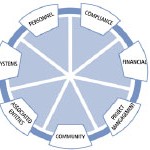Contact Us
+61 419 533 234
The key elements to successfully implement a risk management program are:
Executive commitment: The active ongoing support of the Board, CEO and senior management is of vital importance – tone at the top. In addition, identifying a member of staff in a senior position to ‘champion’ the risk management program is critical to ensure commitment at all levels.
The Risk Champion’s role is to facilitate, advise and to co-ordinate the risk management activities throughout the organisation. The Champion is the reporting agent and should be action orientated.
Policy and Procedures: Development and promulgation of a clear risk management policy and procedures manual detailing who is responsible and accountable for managing the different categories of risks. Policy and procedures should clearly outline the processes and methodology of reporting risk management activities.
Operational Framework: Clearly outline the risk management program including roles and responsibilities, methodology, structure and approach.
Training and Education: Provide on-going training and education to staff and other stakeholders on the key exposures and methods of applying the principles of sound risk management.
Monitor and Review: Develop a process of continuous monitoring and review to ensure that changes in the organisation’s environment and operating practices are adequately captured and reflected in the risk management plan. Communication and consultation should occur throughout the risk management process to ensure that all staff and stakeholders are appropriately briefed at all times.
WynRisk is perfect for this scenario

